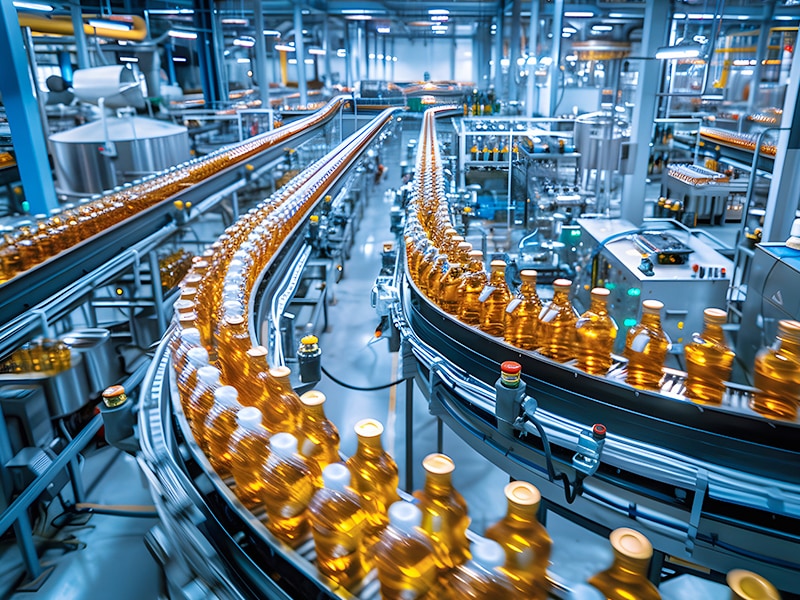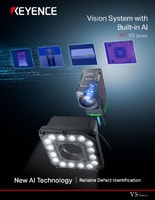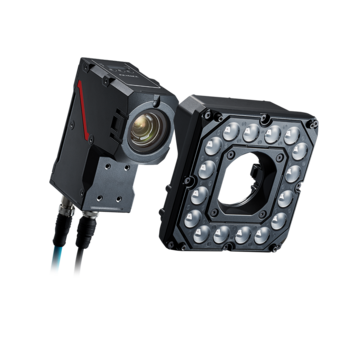Vision Systems
- Vision System with Built-in AI VS series
- Intuitive Vision System CV-X series
- Customizable Vision System XG-X series
- GigE camera and lighting for PC-based machine vision VJ series
- Inline 3D Inspection 3D Vision series
- 3D Vision-Guided Robotics 3D VGR series
- Line Scan Technology Line Scan series
- 2D Vision-Guided Robotics 2D VGR series
- LED Lighting CA-D series
- Lenses (for Machine Vision) CA-L series
- Machine Vision System Database VisionDatabase series
- Automotive
- Automation Equipment/Machine Building
- Electric Vehicles
- Medical Device Manufacturing
- Food/Beverage Packaging
- Semiconductor/Manufacturing Electronics
- Vision-Guided Robotics
- Solar
- Logistics
- Commodities
- Paper Manufacturing
- Machine Tools
- Electronic Device
- Printing
- Mining/Metals
- Fabric/Textile
- Tobacco
- Marine
- Aerospace
4 Ways Vision Systems Revolutionize Inspection in the Food Industry

The days of manual inspection for high-volume production lines are over. Vision systems are the modern answer and future of inspection in the food industry. These technologies revolutionize how food inspections are carried out. They can detect the slightest contaminants, defects, and irregularities in food products with great speed and accuracy.
Importance of Inspection in the Food Industry
The authorities and regulatory bodies take matters concerning consumer health and protection seriously. Sending food products with issues into the market can expose a food company to costly fines, bad reputation, loss of revenue, and lawsuits. To avoid such situations, food companies spend thousands of dollars hiring employees to conduct visual inspections throughout production.
Whether a company is producing a few hundred or a million food products each day, it needs accurate inspections to:
- Detect defects and contamination
- Protect consumer health
- Reduce recalls
- Comply with regulations
- Maintain quality control
- Enhance brand reputation
- Increase customer loyalty and trust
However, manual inspection with human vision can’t guarantee accurate and consistent results in these areas. Companies are now turning to vision systems for inspections in high-speed production facilities.
We’re here to provide you with more details.
Reach out today!

Advantages of Vision Inspection Systems for Food Products
From detecting contaminants to streamlining production lines and reducing errors, modern vision inspection systems are key additions to production processes in the food industry. Human vision helps in manual inspection but cannot be relied upon for high-volume or large-scale inspections. Here are four areas in which machine vision is transforming inspection in the food industry:
Detecting Contaminants and Defects in Food Products
Broken glass, plastic, wood, or other foreign materials could infiltrate food packages. Machine vision systems use a combination of cameras, software, and AI detection algorithms to identify these contaminants. Machine vision cameras can read plastic or paper test strips to identify contaminated products and automatically set them to the side, reducing the risk of human error. They can also send flagged captured images to a human inspector to make a final decision.
Multi-spectral lighting is another example of technology used with vision systems. These devices use advanced imaging technology to spot foreign objects in food products. They also help identify defects and other irregularities that the human eye can’t detect. These and many more advances in vision systems help ensure food quality.
While the human eye has been an inspection tool in the food industry for a long time, it’s susceptible to fatigue and vision-related problems. Plus, the human inspector is likely to be affected by mental distractions or their environment. The use of machine vision for inspection in the food industry eliminates costly inspection mistakes that could lead to recalls, bad press, or fines from regulatory bodies.
In fast-moving manufacturing lines, where human vision cannot detect tears in bottle wraps or creases in food trays, machine vision equipped with high-quality cameras, fast processors, and AI-detection systems can detect even the tiniest irregularities.
Real-Time Inspection for Identifying Potential Hazards
Manufacturing and production processes in the food industry benefit from the real-time inspection provided by machine vision systems. With production lines moving rapidly, foreign objects could find their way into products or packaging without being detected by human eyes. Many vision systems come with high-precision cameras and built-in AI learning models to detect and identify even the slightest deviation from preset criteria right there on the production line. Some of these vision systems not only rely on rule-based programming but can also learn from data to identify and isolate in real-time irregularities that could lead to health hazards.
Enhanced Safety and Efficiency
Machine vision systems can track raw materials, ingredients, and finished goods for incorrect labeling, mismatched bar codes, etc, throughout production. This helps ensure safe products get into the market. Machine vision systems can also create detailed records for each package and batch throughout the production process for future reference, ensuring efficiency in business operations.
Modern vision technologies like the KEYENCE VS Series are equipped with advanced features for enhanced identification and classification. The VS Series, for example, comes with the ZoomTrax image resolution module for quality image capturing and the LumiTrax lighting feature for brightness and glare reduction. These and many more capabilities offered by the AI vision system improve efficiency.
Streamlining Production Lines and Reducing Errors
The goal of every manufacturing or production company is to make its production workflow simple and effective. Machine vision inspection in the food industry can help streamline production processes and activities.
For example, instead of having employees stationed at different equipment and workstations in the production line for manual inspection, vision systems with high-resolution cameras can be used and achieve far better results. Vision systems reduce the need for human workers and resources to care for them, allowing employees to better channel their efforts to other areas in the business where a human touch is more important.
Manufacturing and production companies also use vision systems to minimize errors. These technologies can recognize subtle nuances in types, colors, and sizes that human inspectors are unfamiliar with or for which they lack the necessary training.
The Transformative Impact of Vision Systems and Industrial Automation in Food Safety and Inspection
Vision systems used for food products play a key role in faster, more accurate food inspection, better than what human inspection can achieve. With machine vision systems, food manufacturing companies have been able and continue to inspect millions of product units in a relatively short time. This helps to deliver safe and quality products to consumers.
For industrial food vision technology installation, KEYENCE is always ready and available to help customize automated vision systems that are easy to set up and manage. Our expert engineers will gladly inspect your food production or manufacturing line, discuss your needs, and provide recommendations.
To learn more, contact us today.
Contact us to learn more about how our advanced technology can help take your business to the next level.
Contact Us
Related Products
Industries
- Automotive
- Automation Equipment/Machine Building
- Electric Vehicles
- Medical Device Manufacturing
- Food/Beverage Packaging
- Semiconductor/Manufacturing Electronics
- Vision-Guided Robotics
- Solar
- Logistics
- Commodities
- Paper Manufacturing
- Machine Tools
- Electronic Device
- Printing
- Mining/Metals
- Fabric/Textile
- Tobacco
- Marine
- Aerospace





